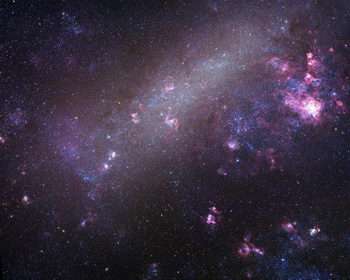Magellanic Clouds May Be Just Passing Through

The Large Magellanic Cloud (LMC) and Small Magellanic Cloud (SMC) are two of the Milky Way's closest neighboring galaxies. Both are visible only in the southern hemisphere. By studying their orbits, astronomers can learn about both the histories of the Clouds and the structure of the Milky Way (from its influence on the Clouds' motions).
Astronomers Nitya Kallivayalil and Charles Alcock (Harvard-Smithsonian Center for Astrophysics) and Roeland van der Marel (Space Telescope Science Institute) have made the most accurate measurements to date of the three-dimensional velocities through space of the LMC and SMC. Their surprising results hold profound implications for both the Milky Way and its companions.
"We found that the velocities of the LMC and SMC are unexpectedly large - almost twice those previously thought," says Kallivayalil.
These findings were presented today in a press conference at the 209th meeting of the American Astronomical Society.
The radial velocities (motion along the line of sight) for both Clouds are well known and relatively easy to measure.
Much more difficult to measure is the proper motion (motion across the sky), requiring extraordinary precision over the course of several years. Both proper motion and line-of-sight motion must be known to calculate the true 3-d velocity.
By making two sets of observations two years apart with NASA's Hubble Space Telescope, Kallivayalil and her colleagues calculated accurate proper motions for the LMC and SMC. By combining proper motions and radial velocities, they found that the LMC speeds through space at 378 km/sec (235 miles/sec) while the SMC has a speed of 302 km/sec (188 miles/sec).
There are two possible explanations for these high speeds:
1) The mass extent of the Milky Way is larger than previously thought. If the Clouds are gravitationally bound to the Milky Way, then the Milky Way must be much more massive than previous data suggested. The excess mass would pull on the Clouds, keeping them "close at hand."
2) The Magellanic Clouds are not gravitationally bound to the Milky Way. If previous calculations of the Milky Way's mass are accurate, then the Galaxy is not massive enough to hold onto its companions. In a few billion years, they will escape from the Milky Way.
"The Magellanic Clouds may not be true companions of the Milky Way," explains Kallivayalil. "Perhaps they are travelers just passing through the neighborhood."
The velocities of the Magellanic Clouds relative to each other also are surprisingly high. This suggests that the Magellanic Clouds may be coincidental companions and are not gravitationally bound to each other. Alternatively, their high velocities may explain why these two galaxies, if bound, did not merge with each other long ago.
Future measurements of the Magellanic Stream--a long streamer of hydrogen gas trailing behind the Clouds--may clarify the previous paths of the Clouds and their relationships with each other and with the Milky Way.
"Regardless of what future work finds, our study shows that we need to reassess the orbital histories of the Clouds," says Kallivayalil.
Source: Harvard-Smithsonian Center for Astrophysics

















